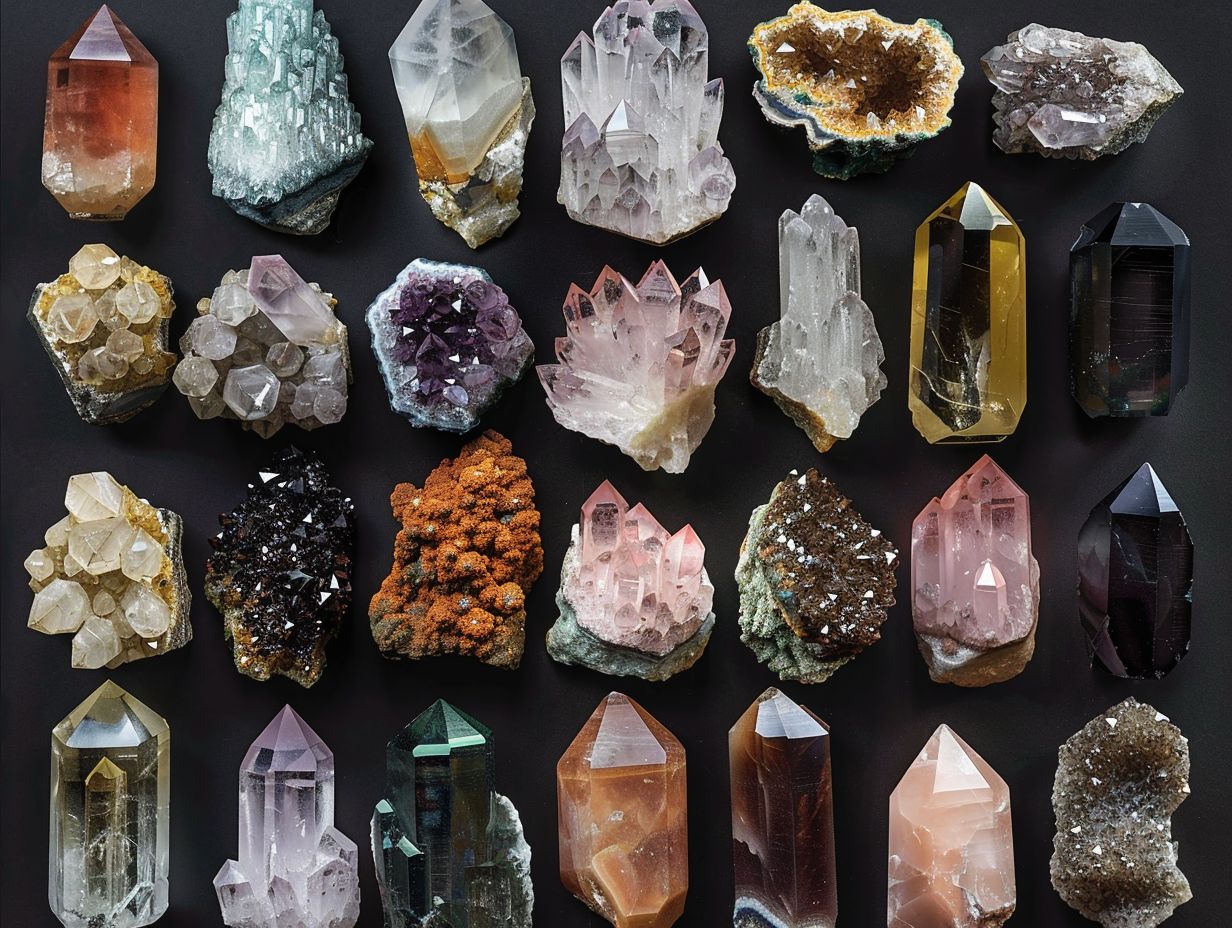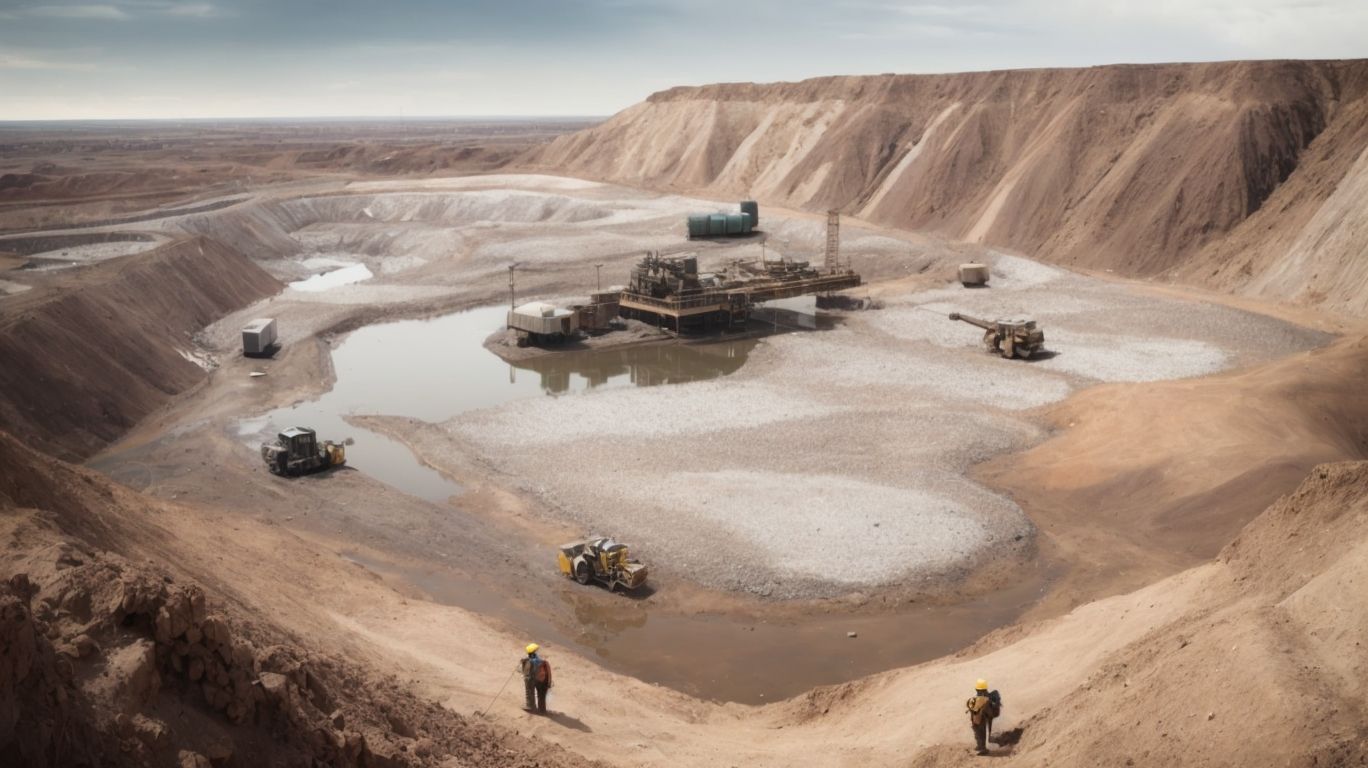
Exploring the Depths: The World of Crystal Quarrying
Have you ever wondered where those beautiful crystals you see in jewelry and home decor come from?
Crystal quarrying is the process of extracting these precious gemstones from the Earth’s depths. We will delve into the world of crystal quarrying, exploring what crystals are, how they are formed, where they can be found, and the various methods used to extract them.
We will also discuss the uses of crystals, the environmental impacts of quarrying, and how this practice can be done sustainably. Join us on a journey to uncover the fascinating world of crystal quarrying.
What Is Crystal Quarrying?
Crystal quarrying refers to the process of extracting valuable crystals from natural deposits through exploration and mining.
- Geological exploration plays a crucial role in identifying potential crystal-rich areas for quarrying. Geologists use various techniques such as conducting geological surveys, analyzing rock formations, and studying mineral compositions to locate sites with high crystal concentrations.
- Once a promising area is identified, the extraction process begins, involving methods like open-pit mining or underground excavation. Tools like drills, explosives, and heavy machinery are employed to access the crystal-bearing rocks and extract them efficiently. This meticulous process ensures the responsible extraction of valuable minerals while minimizing environmental impact.
What Are Crystals?
Crystals are naturally occurring solid substances with a highly ordered internal structure that exhibit unique properties such as clarity, color, and geometric formations.
They are formed through the process of crystallization, where atoms or molecules arrange themselves in a repeating pattern to create a crystal lattice. This unique crystal structure gives rise to a variety of gemstones such as diamonds, quartz, and amethyst, each with its own distinct physical and metaphysical properties. The crystal clear nature of some gems, like diamonds, reflects their ability to transmit and refract light, resulting in their captivating sparkle and brilliance.
How Are Crystals Formed?
Crystals are formed through a series of geological processes that involve the gradual growth and arrangement of mineral elements into distinct crystalline structures.
This process begins with nucleation, where individual molecules come together to form the initial building blocks of the crystal. As more molecules join in, crystallization occurs, leading to the formation of a solid crystal lattice with specific repeating patterns.
The crystal growth then proceeds through the incorporation of additional molecules into the lattice, either through surface growth or bulk diffusion. This growth pattern ultimately determines the final shape and size of the crystal, guided by principles of crystallography and influenced by factors such as temperature, pressure, and chemical composition.
Where Can Crystals Be Found?
Crystals can be found in various geological settings, ranging from caves and caverns to mineral-rich deposits deep underground.
These shimmering gemstones are sought after by enthusiasts and geologists alike, leading to a fascinating world of crystal hunting. Explorers venture into remote areas, investigating intricate rock formations and hidden crevices in search of these mesmerizing treasures. The process of exploration plays a vital role in uncovering the diverse locations where crystals occur, shedding light on the natural beauty and wonder that lie beneath the surface of the Earth.
From sparkling geodes tucked away in underground caves to glittering crystals nestled within ancient rock formations, each discovery adds to the intricate tapestry of our planet’s mineral riches.
What Types of Crystals Can Be Found in Different Locations?
Different locations yield a variety of crystals, each with unique mineral compositions and gemstone properties that reflect the geological conditions of their formation.
For example, quartz crystals are commonly found in granite and pegmatite rocks, while amethyst crystals are often discovered in geodes within volcanic rocks.
Gemstone mining techniques vary depending on the type of crystal being extracted; for instance, underground mining is utilized for deep-seated deposits, whereas open-pit mining is more suitable for surface-level gemstones like topaz.
Mineralogy research plays a crucial role in identifying and grading crystal specimens, as it helps in the classification of minerals based on their physical and chemical characteristics.
What Are the Methods of Crystal Quarrying?
Crystal quarrying can be carried out through various methods such as open-pit mining, underground excavation, hydraulic techniques, and solution mining.
- Drilling is a crucial aspect of crystal extraction, with different techniques employed depending on the mining environment. In open-pit mining, large drills mounted on vehicles are commonly used to bore into the earth and reach the crystal deposits.
- Underground excavation involves the use of specialized drilling rigs that navigate narrow tunnels to access the mineral veins.
Safety measures such as ensuring proper ventilation, wearing protective gear, and regular equipment maintenance are essential to prevent accidents during the drilling process. Quartz, a popular mineral extracted through drilling, requires precision and care to avoid damage and ensure high-quality extraction.
Open-pit Mining
Open-pit mining involves the extraction of crystals from surface excavations, allowing for extensive rockhounding and lapidary activities to recover valuable specimens.
Rockhounding plays a crucial role in the collection of crystal specimens within open-pit mining sites. Rockhounds, enthusiasts passionate about hunting for rocks and minerals, meticulously search through the unearthed crystal deposits in search of unique and high-quality specimens.
Once these specimens are carefully selected, lapidary practices come into play. Lapidaries skillfully cut, shape, and polish the crystals to enhance their natural beauty and highlight their inner characteristics. The process of gem cutting adds significant value to these crystal specimens, making them desirable for collectors and enthusiasts alike.
These activities not only contribute to the appreciation of mineral resources but also promote the importance of preserving and showcasing the beauty of earth’s treasures.
Underground Mining
Underground mining involves accessing crystal deposits through cave systems, requiring spelunking skills for exploration and safe cavern navigation.
Crystal quarrying presents a unique set of challenges beyond typical mining operations. The intricate network of underground tunnels can be maze-like, posing dangers such as cave-ins and unexpected rock formations.
In this subterranean world, adventurers equipped with specialized gear embark on thrilling expeditions to unearth these precious crystals. The significance of spelunking expertise cannot be understated, as it plays a crucial role in ensuring the safety and success of each expedition.
These underground adventures demand a combination of physical endurance, mental acuity, and a deep respect for the mysterious beauty hidden within the depths of the earth.
Hydraulic Mining
Hydraulic mining utilizes high-pressure water jets to extract crystals from mineral deposits, facilitating on-site mineral analysis and extraction processes.
This technique involves using the force of water pressure to break up the rock and sediment surrounding the crystals, making it easier to extract them without damaging their structure.
Once the crystals are brought to the surface, mineral analysis is crucial for determining their quality and market value. Gem cutting tools are then used to shape and polish the crystals into beautiful, marketable pieces, ready to be sold to collectors and jewelry makers around the world.
Solution Mining
Solution mining involves dissolving soluble minerals to extract crystals, requiring in-depth mineralogy research and understanding of mineral chemistry for efficient extraction.
Mineralogy research plays a crucial role in solution mining as it helps identify the specific soluble minerals present in a crystal quarry. By studying the mineral chemistry of these substances, miners can determine the most effective dissolution processes to extract the crystals successfully. Understanding the crystal lattice, which is analyzed through crystallography, further aids in developing strategies for precise extraction methods. This comprehensive approach ensures that the mining process is both efficient and sustainable, maximizing the yield of high-quality crystals.
What Are the Uses of Crystals?
Crystals serve various purposes, from being used in gem cutting for jewelry to applications in crystal healing practices for emotional and physical well-being.
Gem cutting involves the precise shaping and polishing of crystals to create stunning gemstones that adorn jewelry pieces, reflecting light and enhancing their beauty. Beyond their aesthetic value, crystals also hold significant energetic properties, with different types believed to emit specific frequencies that can positively impact the mind and body. The gemstone market thrives on the allure of these unique crystals, catering to jewelry designers, collectors, and individuals seeking to harness the innate power of crystal energy in various forms of spiritual and holistic practices.
Healing and Spiritual Practices
Crystals are widely used in healing and spiritual practices, with practitioners harnessing their unique energy and properties for emotional and physical well-being.
Many believe that crystals have the ability to emit and absorb energy vibrations that can help align the body’s energy centers, known as chakras, promoting balance and harmony. Each crystal is said to possess its own energetic frequency, resonating with specific chakras to address various physical, emotional, and spiritual concerns.
Through the process of crystal healing, individuals aim to clear blockages in their energy channels and tap into the healing power of these natural resources. This practice is rooted in the idea that our bodies are deeply interconnected with the energy of the earth, and by incorporating crystals, we can support our overall well-being on multiple levels.
Industrial and Technological Applications
Crystals find extensive industrial and technological applications, including their use in optics, fashion accessories, and cutting-edge gemstone designs.
Their unique properties, such as crystal transparency and durability, make them ideal for applications in mineral optics where precise light manipulation is crucial.
In advanced manufacturing processes, crystals play a key role in producing high-quality components and precision instruments.
In the fashion industry, the allure of gemstone fashion has led to an increased demand for innovative designs incorporating crystals, showcasing their beauty and versatility in various accessories and clothing items.
Decorative and Jewelry Purposes
Crystals are prized for their aesthetic appeal and unique properties, making them highly sought after for decorative purposes and intricate gemstone cutting techniques.
Gemstone properties play a crucial role in determining the structural integrity, color variations, and refractive index of each crystal, influencing the final brilliance of the cut gemstone.
Craftsmanship in gemstone cutting involves expert precision to enhance the natural beauty and maximize light reflection within the stone, showcasing its inherent qualities.
The market demand for high-quality gemstones continues to grow, with collectors and jewelry designers seeking stones that exhibit superior clarity, color consistency, and unique patterns, driving the importance of gemstone grading standards in the industry.
What Are the Environmental Impacts of Crystal Quarrying?
Crystal quarrying can have significant environmental impacts, leading to issues such as land destruction, water pollution, and deforestation in mining areas.
The process of crystal quarrying involves blasting and excavating large areas, resulting in the destruction of natural habitats and ecosystems. This disruption can displace wildlife populations and undermine biodiversity in the region. The chemicals and heavy metals used in the extraction process often seep into nearby water sources, causing contamination and posing risks to both aquatic life and human health. The continuous extraction of crystals can deplete the Earth’s finite mineral resources, leading to long-term environmental degradation and impacting future generations’ access to these valuable natural treasures.
Land and Habitat Destruction
The process of crystal quarrying often results in land degradation and habitat destruction, impacting ecosystems, mineral classifications, and leading to mineral fractures in geological structures.
This activity not only disrupts the natural balance of the surrounding environment but also poses a significant threat to various species that rely on these habitats for survival. The classification of minerals plays a crucial role in understanding their properties and uses, and by disturbing these mineral formations, the process of quarrying can have a ripple effect on the ecosystem.
Mineral fractures, caused by the extraction of crystals, can alter the composition of the land, making it less stable and more prone to erosion and degradation. The disturbances in the mineral cleavage during the quarrying process further exacerbate these adverse effects on the ecosystem.
Water and Air Pollution
Crystal quarrying activities can contribute to water and air pollution through the release of harmful substances, affecting mineral valuation and creating distinctive mineral streaks in the environment.
The excavation process involved in crystal quarrying can disturb the natural balance of ecosystems, leading to heightened levels of sediment and toxic materials being carried into nearby water bodies. This influx of contaminants not only alters the composition of water sources but also impacts aquatic life, disrupting ecosystems.
Air quality is also compromised as dust particles and emissions from quarrying activities disperse, posing health risks to surrounding communities. As a result, the mineral valuation of the affected area may decrease due to perceived environmental degradation caused by these activities.
The identification of mineral streaks in impacted zones can serve as visual indicators of the disturbance caused by extensive quarrying operations, with changes in mineral color denoting potential mineral composition alterations.
Deforestation and Erosion
Crystal quarrying operations can contribute to deforestation and erosion, disrupting ecosystems, resonating crystal structures, and influencing the design of gemstone creations.
The connection between crystal quarrying and environmental impact is profound, with the removal of trees and vegetation leading to soil erosion and habitat destruction. Beyond the ecological repercussions, the resonance of crystal structures extracted from quarries plays a pivotal role in gemstone design aesthetics. Mineral fracture patterns and crystal clarity are key determinants in shaping the unique appeal of gemstones, influencing how designers craft jewelry pieces to showcase the inherent beauty of these natural formations.
How Can Crystal Quarrying Be Done Sustainably?
To ensure sustainable crystal quarrying practices, it is essential to focus on the reclamation of mining sites, eco-friendly techniques, and support for ethical mining practices.
Reclaiming mining sites after crystal quarrying not only helps restore the environment but also ensures the long-term sustainability of the industry. Utilizing eco-friendly mining methods such as using renewable energy sources, reducing water consumption, and minimizing carbon emissions can significantly reduce the environmental impact of the extraction process.
Ethical considerations in the gemstone industry play a crucial role in promoting fair labor practices, avoiding exploitation, and supporting local communities. Mineral fluorescence, a unique property of certain gemstones, can be used to identify sustainable practices and traceability in the supply chain.
Reclamation and Rehabilitation of Mining Sites
The reclamation of mining sites post-crystal quarrying is crucial to restoring natural balance, preserving crystallographic symmetry, and ensuring the certification of ethically sourced gemstones.
By focusing on symmetry preservation during the reclamation process, it becomes possible to maintain the inherent beauty and structure of the crystals that have been extracted. Gemstone certification standards play a vital role in guaranteeing the authenticity and quality of the crystals, assuring buyers that they are getting genuine and ethically sourced gemstones. Ethical sourcing practices not only contribute to sustainable mining practices but also reduce the prevalence of crystallographic defects in the final products, ensuring a higher standard of quality in the gemstone market.
Use of Eco-friendly Mining Techniques
Employing eco-friendly mining techniques in crystal quarrying operations can minimize environmental impact, align with crystallographic systems, and enhance the appraisal process for gemstones.
By implementing sustainable mining approaches, the industry can reduce water and air pollution, conserve natural habitats, and promote local community involvement.
Understanding the complex crystallographic system of gemstones is crucial for accurate evaluation and authentication. Gemstone experts play a key role in identifying rare and valuable crystals, ensuring fair pricing, and ethical sourcing practices.
Incorporating eco-friendly practices not only benefits the environment but also adds value to the gemstone market through transparency and responsible sourcing.
Support for Ethical and Fair Trade Practices
Promoting ethical and fair trade practices in the crystal industry is essential for ensuring the value of gemstones, enhancing mineral fluorescence, and upholding transparency in the supply chain.
This emphasis on ethical sourcing not only guarantees that the gemstone value remains intact, but also plays a significant role in monitoring mineral fluorescence indicators. Mineral fluorescence serves as a crucial quality marker in assessing the authenticity and quality of crystals.
Without proper ethical practices, the true value of these gemstones can be compromised, affecting not only their appearance but also their rarity and desirability in the market. Transparency is key in ensuring that consumers have access to accurate information about the origins of their crystals, fostering trust and accountability within the gemstone industry.




No Comments